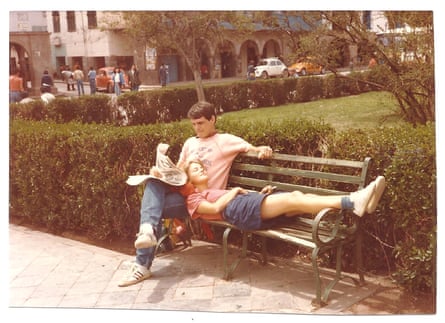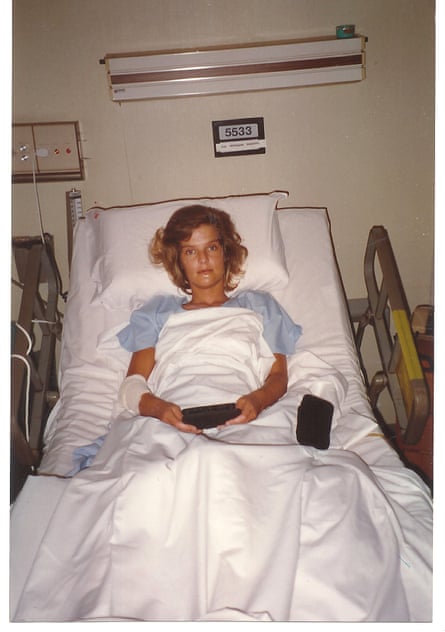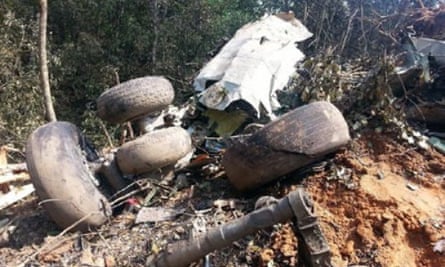[ad_1]
Annette Herfkens and her fiance, Willem van der Pas, had been together for 13 years when he booked them on to a flight from Ho Chi Minh City to the Vietnamese coast. After six months of working in different countries, it was meant to be a romantic break. Van der Pas was a banker, Herfkens a trader. The plane was tiny, just 25 passengers and six crew. Being claustrophobic, Herfkens initially refused to board. To placate her, Van der Pas – “Pasje” as he was to her – fibbed that it was only a 20-minute flight. But 40 minutes had gone by when the plane dropped sharply. Van der Pas looked at her. “This I don’t like,” he said nervously. The plane dropped again. He grabbed her hand – and everything went black.
When Herfkens came to, the sounds of the Vietnamese jungle were coming through a jagged hole in the fuselage. The plane had crashed into a mountain ridge. A stranger lay dead upon her. Pasje, a little way off, lay back in his seat, also dead, a smile upon his lips.
“That’s where you have fight or flight,” says Herfkens. “I definitely chose flight.”
The next thing she knew, she was outside in the jungle. She still doesn’t know exactly how she escaped the plane, remembering the experience mostly in pictures, an instinctive sensory edit – she has worked hard to forget the smells.

She sounds matter-of-fact, but she has had time to become analytical about her behaviour: the crash happened 30 years ago, in November 1992. “That’s probably self-protection,” she says now. She is speaking on a video call from her holiday home in the Netherlands (she is Dutch, but usually lives in New York). “It must have been excruciating pain to get out of there.” First there was “the emotional pain of seeing Pasje dead”, and then the physical pain: 12 broken bones in her hip and knee alone; her jaw was hanging; one lung had collapsed. “So I must have crawled out of the plane and lifted myself down. And then I must have crawled another 30 yards” – away from the wreckage.
The most vivid image from the hours that followed the crash, and from the subsequent eight days Herfkens spent in the jungle with the moans and cries of her fellow survivors slowly silencing, was of being “surrounded by leaves”. Green and golden, sequinned with dew, sunlit through her eyelashes. Time and again, Herfkens turned her focus on them, their light, their colours, movements, away from the man beside her, now dead, away from the white worm crawling out of his eyeball and the leeches on her own skin.
“If you accept what’s not there, then you see what is there,” she says. She calls this idea the “elevator pitch” for her book, Turbulence: A True Story of Survival, as well as the film or TV series she is writing. (A famous actor wanted to make the film before Covid, but the project stalled in the pandemic.) “I accepted that I was not with my fiance on the beach … Once I accepted that, I saw what was there – and it was this beautiful jungle,” she says.
Beautiful? Did she really see it that way? Far from fearing the jungle, Herfkens says that since her escape she has sought it out in her mind. For three decades, it has been her “safe place”, somewhere to will herself back to at times of stress and emotional need or even in transcendent moments of meditation. But how could the very place her life had crumbled around her – her partner dead, along with the future they envisaged together – shift from being a place of peril to a haven?
For Herfkens, the transformation began in the hours immediately after the crash. While she lay injured and thirsty, waiting to be rescued, she thought of the bond markets. She had been working for Santander in Madrid, and had been the only woman on the trading floor. She also thought of her mother back in The Hague. It seems incredible, given that she had no food or water, but while she waited for the rescue party, who eventually carried her down the mountain on a hammock, what Herfkens did not think was that she was going to die.
“I stayed in the moment,” she says. “I trusted that they were going to find me … I did not think: ‘What if a tiger comes?’ I thought: ‘I’ll deal with it when the tiger comes.’ I did not think: ‘What if I die?’ I thought: ‘I will see about it when I die.’” She describes this experience of “moment after moment after moment” as mindfulness before its time, before we all knew the word for it.
In some ways, this mindfulness was foisted upon her by her body. When, after a couple of days, the man who had been beside her died, Herfkens realised she was alone in the jungle. “And I had never been so entirely alone. I panicked.” Her collapsed lung made it hard to get the air in. She had to breathe intentionally. “And by breathing, I got back into the moment, back into the now.”
Herfkens, who now works as an inspirational speaker, has often thought about what enabled her to survive – why was she the only one to make it? Did her innate qualities somehow equip her? Over the years, she has come up with lots of explanations. “I was the youngest child – I grew up with a lot of love – but I was left alone. I didn’t have parents telling me what I should do and feel. So I developed instincts.”

Herfkens thinks that she probably has attention deficit disorder and that if she were a child now “they definitely would have diagnosed me”. Growing up, she was reckless and forgetful, routinely mislaying her hockey stick. She learned to be “inventive and charming” and thinks that if she had “had Ritalin as a kid, I would never have developed the qualities I had for surviving the jungle”. (She has experience in this department, because her son, Max, 23, is autistic. Both of them tried Ritalin, but found it inhibited their sense of humour.)
Years later – after Herfkens married her colleague Jaime Lupa, moved to New York and had two children – friends of her daughter, Joosje, and their parents quizzed her on her experience in Vietnam. At dinner parties, she was a prized guest. Some – mostly the dads – pressed books about survival into her hands. Reading them, she realised that in the jungle, her behaviour had been textbook. “I did all the right things,” she says.
She knew she needed water, for instance, so she made a plan. “That’s what they always say – make a plan. I divided it into achievable steps.” From where she lay, she could see the aeroplane’s broken wing, and thought that the insulation material “could work like a sponge”. She propelled her body along on her elbows, damaging them so badly that they would later need a skin graft, until she could reach the tufty fibres. The pain was so great that she fainted. But by then she had eight little balls of the stuff. She needed only to “wait until it rained … and the little balls would fill up with water … Every two hours I would take a sip.” And then – a pattern she follows to this day – “I congratulated myself”, she says. “And that also makes you survive.”
When Herfkens came to write her book and pitch her film, she realised she didn’t only want to write about her own experience in the jungle. She also wanted to write about the people who helped her, the victims of the crash and about her son. “I went to Hollywood and they said: ‘It has to be all about you,’” she says. It felt counter to the qualities that saved her: “I really think that why I survived is because I got over myself,” she says. “You get over your little self, then you get your instinct to work, then you get to connect with other people and then you achieve stuff.”
When her son was diagnosed with autism at two, she found it helpful to apply what she had learned in the jungle to her life in New York. Herfkens felt the news as “a cold hand around my heart”, having read about some people’s experiences of autism – “the aggression … that you’ll never be able to connect to your child”.
“I went through the steps of mourning,” she says. “Because Maxi was typical. He was typical until 18 months. And then I started losing him. So he could say words, and he was very warm. He was very sweet. And then he was gone.” Bit by bit, he unlearned to talk; she felt him “slipping away”, and a very different child emerged from the one she thought she knew. “You have to mourn what’s not there,” she says. “But focus on what is there. With my son, that’s what I did.”
She connected with other parents who had children with autism, and began to see the world around her differently. She noticed groups of volunteers gathering at the corner of Central Park to run with people with disabilities. “It’s this little world. And you pass it. And you don’t give it a second thought. And then all of a sudden you are in this community.”

With her daughter’s friends’ families, conversation revolved around Upper East Side schooling and the best universities. “Then I was in this other world at the same time.” Her circle widened, diversified. “There were many black autistic boys in our circle, and it was so important to the mothers to teach them that when the police came, they had to keep their hands out of their pockets.” The stakes felt frighteningly high. She took Max on dry runs to the police station, drilled him on how to behave if he was arrested. She began to feel greater compassion for the other parents she met, and more connected.
In the months after the crash, Herfkens, who was then 31, bounced back fast. Within three months, she flew back to her office in Madrid. But the legacy of the crash, the losses and traumas, have shaped the decades since. She clutches a water bottle wherever she goes, and still finds the taste of water “better than anything else”. When she flies, she tries to always sit in the front row, because the sight of another seatback reminds her of the weight of the dead body that landed on top of her. Small moments of trauma, such as a friend ordering Vietnamese food, sometimes ambush her.
Herfkens had specialised in developing markets, with a particular talent for “the most imaginative debt-cancelling transactions”, and it’s clear that this specialism helped her in what she calls properly “taking a loss”. She applied this approach in the jungle, to Pasje, and then later in relation to three miscarriages, to Max’s diagnosis and her divorce from Lupa, who died of cancer in 2021 on the anniversary of Van der Pas’s death. But what does she mean exactly? “It’s really feeling it. Really thoroughly taking it,” she says. “You learn from taking losses. It’s painful, and you do it.”
In trading, many people hold on to their positions even while the losses increase, she says. Say you buy shares at £10 and their value drops to £6. “On paper, you don’t feel the loss. But if you sell, instead of £10, you only have £6, so it hurts.” But then you can use the money to buy new shares that will rise beyond the initial £10. “You see? It takes an effort to actually accept the loss. It’s much easier to pretend that it didn’t happen. That’s very human. It’s the same with mourning. You cannot accept it if you don’t feel it … Be aware of it. Not just step over it.”
For Herfkens, survival is an ongoing process. These days, as well as writing her script and giving motivational speeches, she is a carer to Max. Mourning Pasje is “an everyday thing”, stitched into the fabric of daily life. She still uses his method to keep her T-shirts tidy, taking the whole pile out to take one out so they get less messy. “Those little things, you know?”
She has internalised him, her loss of him, and that too is a form of connection. Each year, she marks the anniversary of his death – now also the anniversary of her late ex-husband’s death – and counts each day for the next eight days, each sip of water, too. And then she buys herself a present. “I like treating myself,” she says. “I’m good at that.”
[ad_2]
#survive #sole #survivor #plane #crash
( With inputs from : www.theguardian.com )


































